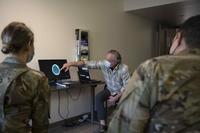Retired Air Force Reserve Maj. Wes Carter almost didn’t travel to Washington D.C. last week where, to his surprise, he heard an independent panel of scientists verify what he had dogged the Air Force and Department of Veterans Affairs about for almost four years.
The Institute of Medicine said Carter and up to 2100 other former reserve air crewmen and maintainers of C-123 aircraft, flown for a decade after the Vietnam War, were indeed exposed to toxic residue from Agent Orange herbicide sprayed from some of the same aircraft during the war.
The IOM also found it plausible that exposure “exceeded health guidelines for workers in enclosed settings. Thus, some reservists quite likely experienced non-trivial increases in their risks of adverse health outcomes.”
The findings likely mean that VA will find more of these reservists eligible for VA medical care and disability compensation if they suffer from one of 14 ailments presumed to be caused by Agent Orange.
Dr. Ralph L. Erickson, VA director of Pre-9/11-Era Post-Deployment Health, said Deputy Secretary Sloan Gibson and other senior staff were briefed on IOM findings last Thursday before public release. That day a “technical work group” of scientists, physicians and experts on VA regulations and benefits held the first of a series of meetings to review and interpret the report and make recommendations to VA Secretary Bob McDonald.
Erickson noted that it was VA that ordered the IOM study and it welcomes the findings “because the better we understand environmental issues, the better we’re able to care for these veterans.”
The IOM findings reflect a deeper understanding of how dioxin contamination on interior surfaces of these aircraft behaved, he said.
“Though we thought before – and this certainly was the Air Force position – that a dry residue was rock solid and it wasn’t going anywhere and it wouldn’t be available to contaminate a crew member, there’s now science available that leads us to understand that, in fact, there is this dynamic equilibrium of the solid residue with the air above the residue…”
Bottom line, it seems, is the VA accepts the possibility that Agent Orange residue could have become airborne and harmed reservists.
Carter said he found VA and Air Force officials more close-minded during a four-year slough to try to win Agent Orange-related care and disability compensation for crews and maintainers who were assigned to reserve squadrons that operated at three bases from 1972 to 1982.
Ill, fatigued and in chronic pain, Carter said he fell victim to dark moments after IOM last fall delayed release of its report by three months. Carter worried that if IOM decided against the crewmen and their claims, he might not be strong enough to continue the fight.
Since 2011, Carter has led an intense bureaucratic battle with his parent service and VA, writing scores of letters, compiling scientific records and internal reports from multiple agencies, contacting news media, creating a C-123 Veterans Association website and blog to explain what the latest evidence showed and how former crewmen were suffering, and posting all documents online for scientists and the public to study.
Carter, now 68, did all this having nothing to gain personally. He has been rated 100-percent disabled since 1990 when he suffered spinal injuries in a fall off an Army truck on the last day of the Persian Gulf War.
But Carter also has three illnesses tied to Agent Orange. Peripheral neuropathy was diagnosed in 1978 after he began losing feeling in his feet at age 32. By 2011 he had prostate cancer and needed heart surgery. When a C-123 crewmate died suddenly, Carter queried other former crewmen and learned of more with illnesses associated with Agent Orange.
Yet claims these reservists filed with VA routinely were denied because the Air Force maintained that the former “spray birds” had posed no environmental hazard to reserve crews, having been decontaminated during conversion for reserve missions.
Through a Freedom of Information Act request, however, Carter got an Air Force report from 1994 showing one aircraft he had flown on, nicknamed Patches, was described as “heavily contaminated” with dioxin, enough so that work crews preparing it for display at a museum wore protective suits.
Carter also discovered that in 1996 Air Force tried to stop a contract to sell C-123s because of contamination. Another document showed officials struggling with how to dispose of the retired aircraft because even burying them could contaminate the ground. They were broken apart and melted.
Carter’s work on the C-123 issue grew from about 15 hours a week that first year to 40. He has spent thousands of dollars on travel, postage and other costs. As VA continued to deny claims based Air Force official findings the aircraft posed no harm to post-war crews, Carter urged other scientists, at universities and government agencies, to reviews air and surface samples collected from a few C-123s in the mid-1990s and one as late as 2009. In 2013 an agency of the Center for Disease Control weighed in and also found crew exposure to dioxin.
Meanwhile, members of Congress began to press officials to explain what Carter and others found.
One Senate staffer who worked with Carter noted his passion and that he was “on the right side of the science and facts here. That was a frustrating issue for all of us: how much logic we introduced in our discussions with the VA, and yet it was more or less a blank stare from them for over three years.”
By December, with the IOM release date reset, Carter told his wife Joan he would skip the trip east and listen from their home in Colorado. But she said he should be in that room, whatever the decision, to support former crewmen who might be there supporting him. Wes asked Joan to join him.
“It felt wonderful to have her in the room when that report was read. She gave up a lot,” Carter said.
Looking back, he said, it should have been VA officials fighting for C-123 veterans, not one of their own rated by VA as catastrophically disabled.
Lincoln at his second inaugural, said Carter, didn’t promise “to care for him who shall have borne the battle -- only if he can talk us into it.”
To comment, e-mail milupdate@aol.com, write to Military Update, P.O. Box 231111, Centreville, VA, 20120-1111 or visit: www.militaryupdate.com
# # # # #
Tom Philpott has been breaking news for and about military people since 1977. After service in the Coast Guard, and 17 years as a reporter and senior editor with Army Times Publishing Company, Tom launched "Military Update," his syndicated weekly news column, in 1994. "Military Update" features timely news and analysis on issues affecting active duty members, reservists, retirees and their families.
Visit Tom Philpott's Military Update Archive to view his past articles.
Tom also edits a reader reaction column, "Military Forum." The online "home" for both features is Military.com.
 Tom's freelance articles have appeared in numerous magazines including The New Yorker, Reader's Digest and Washingtonian. His critically-acclaimed book, Glory Denied, on the extraordinary ordeal and heroism of Col. Floyd "Jim" Thompson, the longest-held prisoner of war in American history, is available in hardcover and paperback.
Tom's freelance articles have appeared in numerous magazines including The New Yorker, Reader's Digest and Washingtonian. His critically-acclaimed book, Glory Denied, on the extraordinary ordeal and heroism of Col. Floyd "Jim" Thompson, the longest-held prisoner of war in American history, is available in hardcover and paperback.




